J & R Howie Hurlford
— 09/10/2024Found by Eddie McLean in the Glasgow area. Hurlford Fireclay Works, Galston Road, Hurlford, Ayrshire. . . . .
1850 – Ferguslie Fireclay Works started.
1851 – 1852 – David Buchannan, Foreman, Ferguslie Fire Brickwork (Page 23).
1851 – 1852 – James Craig & Co. fire-brick, drain, and roofing tile makers, Greenock Road, and Ferguslie Fire Brickworks, Millarston. (Page 30).
Below – 1852 – Advert for James Craig & Co, Caledonian Brick and Tile Works and Ferguslie Clay Works, Paisley.

03/02/1855 – Paisley Herald – The Paisley Burgh Bill … Sources of revenue … The third from the clay fields, the “value of the clay permanently being 5 per cent, £2ooo— 8 years accumulated revenue”. These clay fields lie in the vicinity of Caledonia Street and at present yield rent of about £300 a year. At this rate, the clay will last, according to the opinion Bailie Robert Brown, who in such matters I take be no mean judge – six years but may last eight years. Of course, if the clay is taken out at a less rate than £300 a year, it will just last the longer, but it will be all the better for the Council that it be wrought soon, as the 25 acres of clay land yield little or no rent as arable land while the manufacture of bricks is going on. The Council have taken the clay as fetching £300 a-year, for eight years, which makes £2400. The £4oo has been struck off in the shape of interest, as it will eight years before this sum comes into their hands. The only way the Council had to make the clay a permanent revenue was to capitalise the £2000 got from it, and this sum, at 5 per cent, brings £100 a-year. There is something rather dubious in the position the Council have placed themselves with this clay. It is evident that before a great part of this £100 can be available to pay a dividend, the Council must wait eight years. If they require it all to meet their engagements, they must, in the very first year, eat-in upon their stock to square matters, and away forever goes part of the first £300 obtained from the brickmakers …
Below – 23/11/1855 – Greenock Advertiser – Robert Brown Advert – Caledonian Brick and Drain Tile Works and Ferguslie Fire Clay Works.
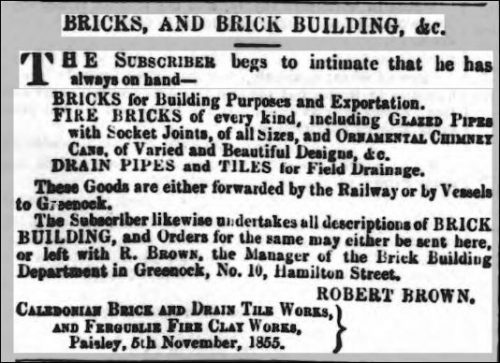
1856 – 1857 – ScotlandsPlaces – This name is applied to a very extensive fire clay and brick and drain tile works and stores, Situated at the East end of Sneddon Bridge, with a neat office adjoining. Flower vases and stands, ornamental chimney pots, glazed sewerage pipes with socket joints, stove covers, gas retorts, flooring tiles, cattle troughs, ground fire clay & compound bricks, etc of every design & [and[ description are to be had at these stores. R Brown Esq . the present Provost of Paisley is proprietor and occupier.
01/06/1856 – South Australian Register Newspaper – Jennings Patent drain pipes – … The remarks of Mr Stephenson and other similar statements by civil and sanitary engineers have led to much attention being paid to the subject of drain and sewage pipes. One of the most approved results of this attention has appeared in the form of Jennings’s patent drain-pipes, the essential principles of which are the perfect absence of all internal inequality of surface at the jointing, and the facility with which portions of the pipe may bo unshipped from the chairs or sockets in which they are laid. The professional journals and magazines of mechanical inventions have spoken in high terms of these patent drain-pipes, but the best recommendation consists in tho fact that they have been very extensively used in many important public works. At the Government prisons, dockyards, barracks, &c., they have been greatly approved; many town councils have adopted them in municipal improvements, and a host of private builders have preferred them to all others. Our colonial experience in such matters is necessarily very limited; and it is to be hoped that if the legislature resolve to adopt, not only the principle of drainage, but a particular scheme of works, they will carefully study the plans, sections, and general descriptions of the proposed undertaking.
Below – 08/05/1857 – Glasgow Herald – Ferguslie Fire Clay Works Advert.

08/08/1857 – Paisley Herald – Highland Agricultural Society Show … there are rick standards, field gates and iron fences of great beauty, weighing machines for carts, and cattle enamelled clay troughs and tiles of every size. Provost Brown of the Caledonian Brick and Drain Tile Works and of the Ferguslie Fire Clay Works is a large exhibitor in these departments … Awards – Section 73 – Glazed socketed pipes for sewage – Premium £1. 1. Robert Brown, Ferguslie Fire Clay Works. 2. P.B.M MaCredie, Perceton, Kilmarnock commended; John Robson, Cook Street, Glasgow, commended.
Below – 1858 – Ferguslie Fireclay and Caledonian Brick and Drain Tile Works stores.

Below – 1858 – Ferguslie Fireclay Works, Paisley.
1858 – Mineral Statistics of the United Kingdom of Great Britain and Ireland for 1858 – Ferguslie, clay of coal measures. Name of freeholder – Earl of Eglinton. Manufacturer – Mr Brown. Manufacture – Bricks, cans, pipes, covers, vases &c. Estimated 12,000 tons annually.
Below – 30/10/1858 – Renfrewshire Independent – Article regarding Provost Brown (Robert Brown) securing 15 acres of the racecourse for the purpose of manufacturing bricks. (Note – SBH – I think this land may have been used to extend the Ferguslie Works but I am not certain).

.

.

1858 – 59 – Daniel Dalglish Agents for Ferguslie fire bricks and glazed drain pipes, 158 Eglinton Street, Glasgow. House 50 Cavendish Street. (Page 87)
Below – 21/04/1859 – Belfast Morning News – Ferguslie Fireclay Works advert.

Below – 30/04/1859 – Greenock Advertiser. – Robert Brown advert for Jennings Sewer Pipes.

Below – 30/12/1859 – Glasgow Herald – Robert Brown, Ferguslie Fire Clay Works, Paisley advert for making and selling Jennings patented pipes … with the liberty to sell in Ireland and in foreign countries.

Below – 1859 – 1860 – George Jennings Sewer Pipes – Ferguslie Fire Clay Works advert.
13/01/1860 – Glasgow Herald – Patent Sewer Pipes – Robert Brown, Ferguslie Fire Clay Works, Paisley has the exclusive right from Mr Jennings, the patentee to make and sell these, now universally admitted superior pipes in Scotland, with the liberty to sell in Ireland and foreign countries. Ornamental chimney cans, vent linings, socket pipes, fire bricks etc. Prices, diagrams and models and every information furnished on application.
City office – 8 St Enoch Square, Glasgow
Glasgow Depot – 158 Eglinton Street
Greenock Depot – 4 Chapel Street
Paisley Do – Sneddon Bridge
27/04/1861 – Paisley Herald – Important case to proprietors of public works. On Thursday, in the absence of Mr Sheriff Campbell, Mr Sheriff Macfarlane presided the usual sitting of the Small Debt Court. Among the cases on the roll which were disposed of, was one of considerable interest to the owners of public works in the town was an action for damages, restricted to £12, against Robert Brown, Esq. of Shortroods, and owner of the Ferguslie Fire-Clay Works, situated about a mile and a half west of Paisley, at the instance of Mrs William Barr, of Ferguslie Place, Paisley. The following is a copy of the charge:— “1861, April 11. —To sum due by you to me, in consequence of the injury and damage done to a thorn hedge, belonging to me on the side of the turnpike road, leading from Paisley to Johnstone, opposite your brick and tile work at Millarston, by heated air or smoke, or other substance coming or being blown from time to time during the preceding ten years from your said work, over and upon the said hedge, whereby it has been injured and damaged and rendered unfit for a proper fence, and in some parts been totally destroyed.” Mr James Caldwell, writer, appeared for the pursuer, and William Hodge, Town-Clerk, for Provost Brown. Hodge urged several preliminary objections to the competency of action, that the pursuer was bound to prove that the damage had resulted from the wilful act or carelessness of the defender and that the pursuer was also bound to specify the time when the damage was done; and also that the pursuer had virtually acquiesced in the establishment of the works, and had therefore lost any claim, and that if there was claim it was at the instance of the pursuer’s tenant, who was bound by his lease to maintain the fences. Mr Hodge further stated that the works had cost Provost Brown the sum of £10,000; that he employed in them about one hundred men and disbursed about £400 monthly in the shape of wages. Mr Caldwell, on the other hand, urged that it was not necessary that he should aver culpable negligence on the defender’s part in conducting his operations – that the action was laid on the broad ground that the defender’s work was a nuisance, doing actual damage to the surrounding property, for which the defender must be held responsible; and in support of this, he quoted a case where a brick kiln in the vicinity of Glasgow had been, by the Court of Session, ordered to be removed. He further urged that it was incumbent on the part of the pursuer to specify a particular time; the injury had done to the property gradually, and it was not only now that the full amount of the damage had been sustained; and that, as regarded the objection that the claim could only be maintained by the tenant, that the pursuer, as proprietrix of the fence, was entitled to insist on the claim. The Sheriff was of opinion that it was not necessary to aver culpable negligence on the defender’s part, as there might be a claim on account of the work being a nuisance without any mismanagement, but he had doubts how far the claim could be maintained in the whole circumstances in its present shape. To a certain extent in towns, public works were nuisances, and caused a certain amount of damage; but, considering their value and importance to the community, it would be entirely out of place to propose that they should therefore be suppressed. In this case, he also considered that too long a period had been allowed to elapse between the establishment of the works and the raising of the action. The pursuer might have applied for an interdict against the works being erected at first, and if the pursuer was more of opinion that she had sustained such a serious amount of damage, the course was to raise an action in the Supreme Court, and lay the matter before a jury; but he did not think it right that a case involving such important interests should be disposed of summarily before a Small Debt Court. The defender was accordingly assoilzied.
Below – 28/06/1861 – Belfast Morning News – Robert Brown advert with reference to Jennings Patent Sewer Pipes.
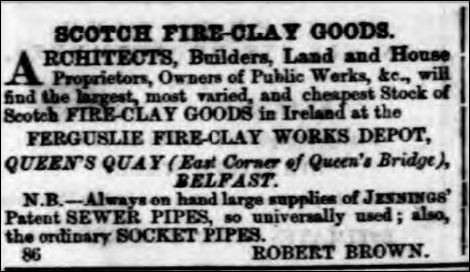
01/08/1861 – Edinburgh Evening Courant – Highland and Agricultural Society Show at Perth.
Pipe or Tile Machine for hand or power, eight sovereigns, George Finlayson, Gighty Burn, Arbroath; …
Tiles or pipes for field drainage. Two sovereigns – Christie & Son, Shore Road, Stirling. 2d. Bronze medal – Alexander Meldrum, Seafield Tileworks, St Andrews.
Glazed socketed pipes for sewerage, three sovereigns John Robson 47 Cook Street, Glasgow, 2d Bronze medal, Robert Brown, Ferguslie Fire clay Works, Paisley. Commended Edmonstone Coal Co, Dalkeith.
Feeding troughs for byres, One sovereign John Robson 47 Cook Street, Glasgow, 2d Bronze medal, Robert Brown, Ferguslie Fire clay Works, Paisley
Extra implements machines etc – Highly commended – Collection of vases, paving bricks, horse manger, pig trough and milk cooler – John Robson.
Below – 1862 – 63 – Advert Robert Brown – Jennings patent sewer pipe.
Jennings Patent Sewer Pipes. Robert Brown, Ferguslie Fire Clay Works, Caledonia and Shortroods brick and drain tile works, Paisley.
Now holds the exclusive right from the Patentee to Manufacture and Sell these pipes in all Scotland, with the liberty to Sell in Ireland and in Foreign Countries.
“Mr George Jennings’ Patent Drain Pipes, as we have before taken occasion today, are certainly the best arrangement that can be used.” – Builder.
The Pipes are the most perfect yet introduced and are universally acknowledged, the only improvement yet effected on the ordinary Socket of Half-Socket Pipe. The following are some of the advantages offered by the use of these Pipes:-
1st, These Pipes, which are plain at both ends, are laid in the rebates of the chair sufficient distance apart to admit of the workman striking up the joint of the invert
perfectly fair on the inside, thus avoiding the burr of the cement or other stopping material being left to impede the flow of sewage, and ultimately stopping up the drain.
2nd, the Superintendent of the Works can insure this being effectually done by personal examination, before allowing the saddle pieces to be put on.
3rd, Facilities for examination, such as no other system of drainage presents, or admits of, as in the event of a stoppage, it is only necessary to remove the Upper Saddle in any way damaging the drain, the only expense being the labour.
4th, Should Branch Drains be required at any future time it is only necessary to remove any one of the Plain Saddles, and to substitute for it a Junction Saddle, as at D which, by turning round, is available for either side of the street.
These pipes with all the advantages they possess are the same price per yard including the Patent Saddle and Cradle, as charged for the ordinary Socket Pipes.
Single Junctions and Bends of every kind, including the Patent Saddle and Cradle, charged as 1 ½ yards; Double Junctions, as 2 yards; and Cesspools, as 3 yards.
The usual Socket Pipes also made, and sold as formerly; along with Ornaments, Chimney Cans, Vent Linings, Joist Shields, Fire Bricks, &c., &c., and all articles made of fire clay.
Machine-made Building Bricks, and also Drain Pipes, and Tiles for Field Drainage of all sizes, and of the best quality.
Prices and all further particulars furnished on application.
Paisley Depot. . . . . . . . . . . Sneddon Bridge
Glasgow Do . . . . . . . . . . . No. 158 Eglinton Street
Edinburgh Do . . . . . . . . . . . Spittal Street
Dublin Do . . . . . . . . . . . 56 North Wall Quay
Belfast Do . . . . . . . . . . . East End of Queens Bridge on Queens Quay.
05/05/1864 – Glasgow Morning Journal – Discusses the Clyde Navigation Bill … Mr Brown, brick and drain pipe manufacturer in Glasgow and Paisley, said he carried on a pretty extensive trade on the coast and the Clyde and objected to the Bill because it would double his rates. He never sent goods from Paisley to Glasgow by the river. He had tried it once but found it to be impracticable. He stated in cross-examination that the Bill would affect him to the extent of L20 (£20?) per annum – no more …
07/05/1864 – Paisley Herald and Renfrewshire Advertiser – Clyde Navigation Bill – Mr Robert Brown examined – l was Provost of Paisley from November 1856, to November 1859. I have two separate works at Paisley, and in one of them, I manufacture drain pipes for field drainage and also common building bricks. The quantity of drain pipes which I make is very large, and about the one half of them is sold in the district and the other half is put into vessels and sent to places on the Clyde and West Highlands of Scotland, and Ireland. The dues present payable on these, for the part they are carried on the Clyde, are one penny per ton. According to the new Bill of the Clyde Trustees, this rate will be rather more than doubled. The quantity of common building bricks which I make is also very large. The best market which I have for these bricks is Greenock, and they are either sent there in boats by the Rivers Cart and Clyde or by railway. The carriage of bricks at present by water to Greenock is 6s 3d per 1000, and by railway, it is 6s per 1000. At present, therefore, the carriage by railway to Greenock is three pence per 1000 under that by the Rivers Cart and Clyde. By the proposed alteration of rates in the new Bill, this difference will be increased to sixpence per 1000. The quantity bricks which I have sent to Greenock by the Rivers Cart and Clyde and railway together during the last three years has averaged about 800,000 yearly. The selling of the bricks and the drain pipes I have to compete with makers upon the side of the railway who are nearer to Greenock than I am, and also with makers upon the side of the Clyde below the River Cart, on the Forth and Clyde Canal, and also the Ayrshire coast. The goods which I manufacture at my other work, called the Ferguslie Fire Clay Works, consist of fire bricks, sewerage pipes, and other articles made of fire clay. I send a very considerable quantity of these goods by vessels down the Rivers Cart and Clyde and which are shipped at Paisley. I have a house in Belfast and also one in Dublin, and the quantity of goods which I send to these places of business is very large. The Clyde dues on these goods are partly one penny and partly fourpence per ton, and by the new Bill are proposed to be more than doubled. In selling these fire clay goods in Ireland I have to compete with some extensive works on the Ayrshire coast, and also in Wales. I have also a place of business in Glasgow to which I likewise send these fire clay goods, but they are forwarded by the Paisley Canal. I never send any goods to Glasgow by the Rivers Cart and Clyde, because the expense and inconveniences attending such mode of transit are such as to make it almost impracticable. Some years since an effort was made to send goods in this way for shipment at the Broomielaw but it had to be given up. I find it to be much better and cheaper to send goods by Paisley Canal to Port Eglinton at Glasgow and then cart them to the ship’s side at the Broomielaw. The quantity of coals which I bring from Glasgow along the Paisley Canal to my Fire Clay Works is about 9000 tons annually, and the quantity of manufactured fire clay goods which I send annually to my place of business in Glasgow is about 4000 tons. I am of opinion that if the dues are increased upon the Clyde as proposed it will very much interfere with my business and that of the other traders on the Cart. The vessels which I engage to ship goods at Paisley do not draw more than 8 feet of water when loaded, and the great depth of the water, therefore, which has been obtained in the Clyde by expensive operations is not required by me or any of the other traders on the Cart. The kind of goods brought to Paisley by the Rivers Cart and Clyde which yields the largest revenue to the Cart Trust is wood and it is about equal to the one half of the whole revenue. The dues paid to the Clyde Trust on this wood is, I believe, fivepence per ton, and by the new Bill, it would eleven pence per ton. I am of opinion that if this increased rate is carried into effect it would be very injurious to the importers of wood, and likewise to the revenue of the Cart Trust. Cross-examined by Sergeant Bellasis—The proposed difference in rates would amount to one penny per ton on the use of 12 miles the River Clyde, but which, however, is the double of the present rates. That would take much from the profits of my business, and looking to the competition that exists in Ayrshire and other places it is of the greatest importance that the means of transit should be as cheap as possible. The quantity of my manufactured goods which I send down the Rivers Cart and Clyde is about 5000 tons annually. This yields about £20 a-year to the Clyde Trust, and if the Bill passed it would be doubled. To the Clyde Trustees who are such a powerful and wealthy body the proposed increase of rates is but a small matter, but the doubling of the rates to the other trustees and myself is of serious importance. At the conclusion of the evidence, the Committee found the preamble of the Bill, in so far as it related to a mileage rate not proved.
04/07/1865 – Belfast News – Scotch Fireclay goods – Scottish fireclay goods. Builders, Contractors, &c., will find the largest and most varied stock of the above goods kept in Ireland at my depots- Queens Quay, Belfast and 56, North Wall, Dublin. The Goods are second to none in the market and at lowest rates, White bricks (extra finished), for Facing, Buildings, in great variety. Also, glazed sewage pipes, with patent or socket joints. Robert Brown. Belfast Depot-Queens Quay. Dublin Depot-56 North Wall. Works, Paisley. N.B.- Goods can be sent to any Port in Ireland, either by sailing vessel or steamer, direct from the works. 4235. The subscribers have for sale:-Garnkirk Fire brick and clay; Allan & Mann’s white building brick the best brick manufactured); J. & M. Craig’s brick, 1st and 2nd qualities; Do, white and red glazed tiles; Sealy’s Bridgewater tiles and bath brick; Staffordshire black brick, various shapes; Chester tiles and brick; Architectural Pottery Company’s ornamental tiles; cements, London, Portland, Roman; hydraulic limes, &c.; chimney cans, water pipes, &c., &c., &c. W.D.Henderson & Sons. Office-14 Corporation Street. YARD-Albert Square. 4113.
1865 – 1866 – Robert Brown, manufacturer of patent machine made bricks, drainpipes and tiles, Caledonia and Short- roods Works; and of fire bricks, patent sewer pipes, &c., Ferguslie Fireclay Works – Town office, Sneddon Bridge – residence, Underwood Park
26/04/1867 – Saunders News Letter – … There are specimens to be seen of the Paisley fire clay pipes, troughs, bricks, tiles and vases exhibited by Brown & Sons from the depot at the north wall …
Below – 11/06/1867 – Belfast Mercantile Register and Weekly Advertiser. Advert for R.Brown & Son, Ferguslie Fire Clay Works.
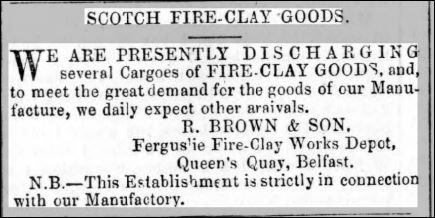
Below – 02/07/1867 – Mercantile Journal – Advert for R.Brown & Son, Ferguslie Fire Clay Works.
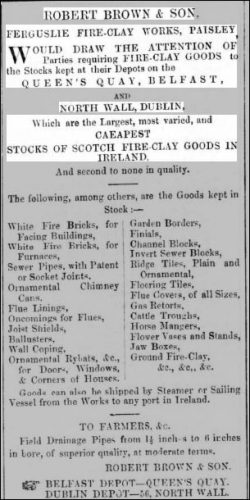
Below – 01/08/1867 – The Dublin Builder – Ferguslie Fire Clay Works, Paisley. Glazed sewer pipes (patent and socket) and all articles made of fire clay of superior quality, for sale at the depot. No 56 North Wall – Quay, Dublin. Robert Brown & Son. Also drainage pipes of all sizes for field drainage. Prices very moderate.
02/11/1867 – Paisley Herald – The half-yearly meeting of the Road Trustees of the County of Renfrew was held on Tuesday, in the Council Renfrew. Sir Robert Napier was in the chair. The minutes of the committee bore that an application had been received from Mr Robert Brown, of the Ferguslie Fireclay and Tile Works, to be allowed to make a railway crossing on the Barnsford Turnpike Road from their works at Shortroods. The committee had agreed to the request. Mr Speir thought Mr Brown ought to be required to pay a way-leave, as other parties had to for their crossings. Mr Salmon said that the case of the iron manufacturers was different. Their traffic was a very heavy one, and there were other parties who had crossings on the roads without having to pay anything for way-leave. The Chairman read a memorial from Messrs James Dunlop & Co., iron manufacturers, requesting to be relieved of their annual payment of £3o for their railway crossing at Linwood, and to be put on the footing as those parties who required to pay nothing. Mr Brown said he was taking an immense traffic off the road by this new route, a traffic which was indeed nearly equal to all the rest of the traffic there. This article was not a valuable one like ironstone and consisted chiefly of bricks and tiles for draining. Captain Speirs suggested that a committee should be appointed to consider whether or not it might be advisable to exempt all from payment for their crossings. After some conversation the matter was arranged, on the suggestion of Mr Gilinour, by Mr Brown agreeing to pay an annual sum of £7 10s for the privilege he asked …
20/11/1867 – Glasgow Herald – Clerk and traveller. Wanted by the subscribers, a steady person of experience and intelligence to act as clerk and traveller. Robert Brown & Son, Ferguslie Fireclay Works and Shortroods Brick and Drain Tile Works, Paisley. 18/11/1867.
Below – 17/03/1868 – Belfast Mercantile Register – Robert Brown bricks exported to Belfast and prices.

Below – 20/04/1868 – Enniskillen Chronicle and Erne Packet. Advert for R.Brown & Son, Ferguslie Fire Clay Works
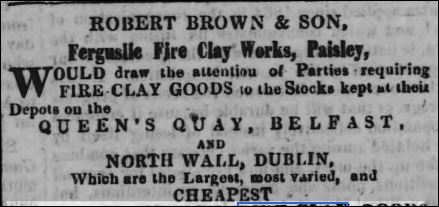
Below – 19/09/1868 – Paisley Herald – The new buildings and street committee – Messrs Robert Brown & Son, of Shortroods and Caledonia Brick and Tile Works, had submitted to the Committee a ground plan of several buildings to be erected by them for another new work between Inchinnan Road and the River Cart, giving notice that the chimney stalk would be 130 feet in height, and also notifying that they intended to cover and divert Bullfauld Burn. The Committee allowed the erections to proceeded with but agreed to give no opinion as to the height of the stalk, and no sanction in regard to the diversion of Bullfauld Burn, that in case existing rights might be affected, Messrs Brown alone might be held responsible.
Below – 1868 – 1869 – Advert Robert Brown & Son – Jennings patent sewer pipe.
1869 – Office, Abercorn Bridge.
Below 1869 – 1870 – Advert for Robert Brown Ferguslie Fireclay Works, Paisley.
19/05/1869 – North British Agriculturist – Paisley, public works on the burgh lands. The large tract of ground belonging to the Burgh Trustees to the north-west of the town promises to prove a valuable source of revenue. For many years much of it has been leased for agricultural purposes, and a considerable portion has been held, chiefly by Messrs Robert Brown and Son, for the manufacture of bricks, tiles, etc., the red clay it contains being of excellent quality and found nearly throughout the whole lands. A few years ago Messrs Merry & Cunningham bored for ironstone on that part of the ground where the racecourse is formed, but the result being unsatisfactory, they abandoned the undertaking. In the course of the operations, however, seams of limestone, coal, and fireclay were found, and Messrs Speirs & Gibb, coal merchants in Paisley, having satisfied themselves that a rich field of minerals existed in the burgh land, secured a lease of the entire underground minerals. Further operations revealed the existence of a bed of very superior fireclay from 12 to 14 feet in thickness, which, it is believed, extends throughout nearly the whole burgh possessions. Messrs Speirs & Gibb are now engaged in flourishing manufacture of fireclay articles. Above the fireclay is a seam of coal of about 2 feet thick, but above the coal is a stratum, several feet in thickness, of excellent limestone, which it is expected will by and by be turned to good account. In the meantime, the manufacture of red bricks, &c., by Messrs Brown is being carried on very extensively on various parts of the lands …
26/06/1869 – Paisley Herald – Excursion of Messrs Robert Brown & Sons, fire clay, brick and drain tile workers. On Saturday last, the workers connected with the Ferguslie Fire Clay Works, and Caledonia and Shortroods Brick and Drain Tile Works, numbering about 500, had their first annual excursion, through the kind liberality of their employers, to Arrochar. The Shortroods workers assembled at St James Street at six o’clock. Headed by the Prince of Wales Royal Renfrew Militia band they marched to the house of Mr John Brown, junior partner, and thence to Well Street, where they joined the Ferguslie Fire Clay Workers and proceeded to the residence of Mr Robert Brown, Underwood Park, senior partner. They marched then to the Abercorn Railway Station, whence they were conveyed per rail to Renfrew, where the steamer “Nelson” was lying ready for them, all receiving, as they stepped aboard, a cordial welcome from the captain, whose care for the comfort and happiness of his large party was as unceasing as it was successful. The general felicitations on the fine weather and the anticipations of a pleasant day on the Clyde were certainly amply fulfilled. Arrochar was reached about eleven o’clock. The excursionists scattering about ashore, some to engage in the mazy dance, and other various amusements and games. Some travelled to the high grounds to view natures wildest grandeur, and said by the poet “It was glorious through the loopholes retreat, to gaze on such a world”. The company left Arrochar at four o’clock, delighted with the result of their visit, and the splendid country which they had witnessed. The party reached Paisley about seven o’clock, breaking up at the County Square.
Below – 1870 – Advert for Robert Brown Ferguslie Fire Clay Works and Caledonia and Shortroods Brick and Drain Pipe and Tile Works, Paisley and 1875 – 1876.
05/05/1870 – Northern Whig – Robert Brown & Son, Ferguslie Fire Clay Works, Paisley.
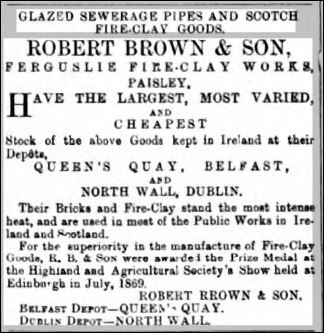
26/12/1870 – Glasgow Herald – Mysterious disappearance – Archibald Black engaged with the vessel Mona, carrying bricks and tiles for Messrs Robert Brown & Son, Ferguslie and Caledonia Brick and Drain Tile Works, mysteriously disappeared about a week ago from Paisley and has not been heard of since. No reason can be assigned for his disappearance. Black is a man about 45 years of age, greyish hair, 5 feet 8 or 9 inches, sharp features and resided 280 Holm Street, Glasgow.
Below – 1871 – Advert – Robert Brown & Son – Ferguslie, Caledonia, Shortroods.
Below – 1870 – 1871 – Robert Brown & Son advert. Edinburgh Depot 17 St Anthony Place, Port Hopetoun off Lothian Road. P 152.
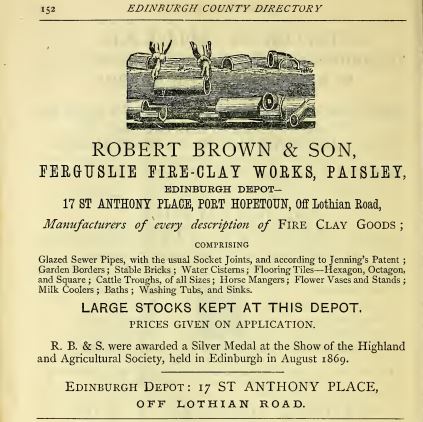
01/07/1871 – Renfrewshire Independent – Excursion – On Saturday last the workers of Messrs Brown & Son, Ferguslie Fireclay Works, Paisley, and Shortroods Brickworks, had their third annual excursion. About 600 workers and friends left for Renfrew by rail and met the steamer Hero, which was especially engaged for the occasion. The excursionists then proceeded to Largs, where they spent a very pleasant day. They were accompanied by the rifle band, which contributed in no small degree to the pleasure of the party.
1871 – 1872 – Robert Brown & Son – Town Office Sneddon Bridge – Works Caledonia, Shortroods & Ferguslie.
30/03/1874 – Glasgow Herald – Brick building – We beg to intimate that Messrs Bell and Mclauchlan, brick builders, No 2 Glen Lane, Paisley have taken a lease at a part of the brickworks at Shortroods, Paisley and we have therefore ceased to manufacture red building bricks and to execute brick building work. As Messrs Bell and McLauchlan were foremen to us in our brick building department for many years we can with the utmost guarantee recommend them to parties with whom we did business and to the public generally. We also beg to intimate that we still continue to carry on the manufacture of drain pipes and tiles for field drainage at Shortroods and likewise to manufacture glazed sewerage pipes and every class of fire clay goods at the Ferguslie Fire Clay Works, Paisley. – Robert Brown & Son, Paisley 27/03/1874.
23/09/1874 – The Scotsman – White enamelled bricks of the best quality are for sale by the subscribers at their Ferguslie Fire Clay Works, Paisley or Depot, 17 St Anthony Place, Port Hopetoun, Edinburgh. These bricks are specially adapted for lining walls in back courts, passages and staircases etc where there is a deficiency of light and for lining walls of school rooms and buildings of any kind to secure cleanliness and supersede painting, whitewashing &c. Robert Brown & Son, Ferguslie Fire Clay Works, Paisley. Sept.1874.
27/07/1875 – Glasgow Herald – Highland and Agricultural Society Show, Glasgow. No visitor in the implement yard will fail to observe and to be pleased with the attractive and tastefully displayed exhibition of fireclay goods and drain pipes by Robert Brown & Son, Ferguslie Fireclay Works, Paisley. Particularly noteworthy are the white enamelled bricks of the same kind as were so much admired recently at the opening of the new ‘Old Clothes’ market in the city where the internal walls are entirely lined with them. The bricks are pure white in colour and they retain freshness and cleanliness rendering painting or whitewashing unnecessary. They also possess the recommendation of durability.
31/07/1875 – Paisley Herald – Messrs. Robert Brown and Son, of Ferguslie Fire Clay Works, and Shortroods Drain Pipe and Tile Works, were awarded a silver medal for their display of fire-clay articles, which were varied in character, and included white facing fire bricks of every design; glazed sewer pipes, with the usual socket joints, and according to Jenning’s patent; white enamelled fire bricks, white enamelled tiles for lining walls; ornamental chimney cans, vent linings and oncomings, joist shields, balusters, wall coping, ornamental rybats, &c., for doors, windows, and corners of houses; garden borders, stable bricks, finials, channel blocks, inverted sewer blocks, bridge tiles, plain and ornamental; flooring tiles – hexagon, octagon, and square; flue covers of all sizes; gas retorts, cattle troughs all sizes; horse mangers, flower vases and stands, byre gutter blocks, milk coolers, drain pipes for field drainage, flower vases, collars for drain pipes, open or horse-shoe drains of the various sizes; roofing tiles, &c. The white enamelled bricks can be used most advantageously lining external walls, in backcourts, passages, &c where there is a deficiency light, and also in lining the internal walls of buildings, such as school-rooms, public works, &c to prevent a close and unhealthy atmosphere, and to secure continuous freshness and cleanliness, while superseding the future necessity of painting, whitewashing, &c.
Below – 1877 – 1878 – Watsons Post Office Directory – Robert Brown & Son, Paisley Sanitary Earternware Works, Paisley and Crown Plumbago Crucible Works, Paisley. (Note – SBH – So where were these works situated – possibly within the site of the Ferguslie Works?)

Below – 1877 – 1878 – Watsons Post Office Directory – Robert Brown & Son, Ferguslie, Caledonia and Shortroods.

Below – 28/07/1877 – Paisley and Renfrewshire Gazette – Messrs R Brown & Son exhibit enamelled bricks at the Highland Show.

1878 – R Brown & Son, Firebrick manufacturers, 158 Eglington Street, Glasgow.
15/02/1879 – Paisley Gazette – Police Board meeting – Smoke nuisance – Sanitary Committee reported that Bailie Clark had informed the committee that several improvements with the view of preventing smoke had been introduced at the Caledonia Fire Clay Works and had also made reference to the means taken tor the same ends at the Ferguslie Fire Clay Works. Mr Fisher expressed the hope that the committee would give that matter every consideration. The Clerk said the committee was waiting for a report from Mr Green, the Sanitary Inspector, in regard to two cases smoke nuisance.
Below – 22/09/1880 – Daily Alta California Volume 32, No 11118.
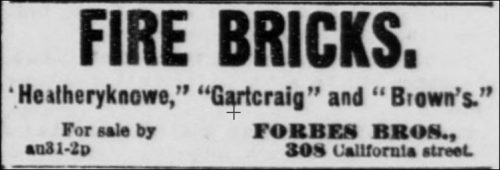
1882 – Robert Brown & Son, Ferguslie Fire Clay Works, Paisley. Office Abercorn Bridge.
15/05/1884 – Sanitary News (USA) -At Chicago. – The regular meeting of the Chicago master plumbers’ association was held at the new rooms on Dearborn Street, on the evening of May 7th. In the absence of President Young the meeting was called to order by Vice-President Boyd and Mr William Oliphant was elected secretary … A letter from Robert Brown & Son, of Paisley, Scotland was read. It will be remembered that these gentlemen made the association a presentation of a number of pieces of ware. The letter was an acknowledgement of the receipt of the engrossed resolutions sent to them by the association some weeks ago. ” We shall always value that document,” they said, ” very highly for the most complimentary and friendly terms in which it is couched. The document itself is quite a work of art and has been executed in excellent taste. We beg to convey thanks to the association for the handsome manner in which it has acknowledged the samples of our ware, which we had pleasure in sending. We shall always be glad to hear of the continued prosperity of your association.”
Below – 26/10/1886 – Edinburgh Evening News – International exhibition – S = Silver, B = bronze and HM = honourable mention.

22/01/1887 – Paisley & Renfrewshire Gazette – Messrs Robert Brown & Sons, Sanitary Earthenware (From the ‘Railway Supplies Journal’. There is no more gratifying development of scientific and inventive skill in the present day than that which we see in the production of sanitary fittings and appliances. We have learnt so much of the defects of former methods in these matters, that one almost wonders how anyone can be living to tell the tale. That our ancestors survived under the imperfect sanitary conditions amidst which they had to live, it is really difficult to explain; but if the general health of the community can be secured by perfect sanitary apparatus, it ought not to be in much danger in these days. We are constantly being called upon to admire some new provision for making our homes and towns more healthy, and, as we examine them, we almost feel that perfection can go no further. This must have been the impression upon the minds of many persons who saw the admirable exhibit of Messr’s. Robert Brown & Son, of the Ferguslie Sanitary Earthenware Works, Paisley. The firm (whose works were established in the year 1851) have long been celebrated for the excellence of their manufactures, and for the very useful improvements which they have introduced to public notice, and the collection of their goods shown at Edinburgh was in every sense worthy of their reputation. Speaking generally of this collection. we may say that it included a variety of cabinet stands, plug basins, lavatories, sinks, and water-closet basins, in different sizes. Particular mention should be made of their patent “perfect” pedestal wash-out closet, for which the firm received the highest award, namely, the silver medal. This apparatus is very highly recommended as possessing the following advantages: The basin and trap being in one piece, and ornamental in design, no woodwork is required further than a hinged seat. By lifting the seat, the closet can be used as a urinal or slop sink, and the wetting so objectionable in fixed seats thereby avoided. All parts and connections being fully exposed and free of access, any leakage or defect can readily be detected and remedied. The flushing arrangements are so constructed as to ensure a rapid and thorough wash out of the basin and trap with a two-gallon flush, while sufficient water is always left in the basin to receive the soil. The outside being concave fluted all-round, an otherwise plain appearance is avoided, and the outer surface thereby easily kept free from dirt or dust, an objection inseparable to closets on the same principle having raised or elaborate ornamental designs. In a sanitary point of view, we believe it is considered the best pedestal closet at present in the market. Their “perfect” wash-out should also be noted, as possessing certain advantages of its own, such as the following: – The outlet of the basin being placed at the front, and completely hidden from sight, the offensive objection of looking into the soil pipe is removed. The outlet of the basin, having a cascade action, causes the soil to fall into the centre of the water in the trap, thereby ensuring speedy exit and cleanliness. The improved fan with which this closet is fitted ensures a thorough and rapid discharge of the contents of the basin with less than two gallons of water. Sufficient water is always left in the basin to receive the soil. The flushing arrangements are complete. Messrs. Brown Son’s exhibit of cabinet stands with high backs and fenders were very much admired, and the gilding and printing, as well as the quality of the goods in general, deserved very high commendation. The firm also showed a large selection of their plain white and coloured glazed earthenware wall tiles, which, for their purity of colour and perfection in manufacture, deserve all that we can say in their favour, as may indeed be gathered from the fact that for this exhibit they received the highest award of a silver medal. Messrs. Brown & Son are, we believe, are the only makers of earthenware wall tiles in Scotland. A bronze medal was awarded to them for the excellence of their white and yellow enamelled fire clayed sinks, and washing tubs, and bricks. Of the bricks, we must say, that it seems to us a great advantage would be secured by using them for lining external walls in back courts, passages, &c., where there is a deficiency of light; and also for lining the internal walls of buildings, such as schoolrooms, factories, stables, &c. ; in as much as they would help to secure a purer atmosphere and would prevent the necessity of painting or whitewashing. Messrs. Brown & Son had a large display of plumbago crucibles, for the smelting of brass, copper, steel, iron, silver, and gold, from the size of a thimble up to pots that can hold 300 lb of metal. These crucibles are well known in the home and foreign markets, and by their acknowledged excellence have secured for the firm a great repute; the honourable mention diploma was awarded them at Edinburgh. Some very pretty designs in vitrified fire clay for garden borders were exhibited, and an immense variety of other articles, everything indeed, that one can conceive of, as made of fire clay, flower vases and stands, milk coolers, finials, balusters, wall coping, ridge and flooring tiles, gas retorts, cattle troughs, horse mangers, and pipes innumerable. It would be difficult to find either in or out of Scotland a manufactory, where these goods are supplied in greater variety, in larger quantities, or in better quality.
31/03/1888 – Paisley and Renfrewshire Gazette – Glasgow exhibition … Robert Brown & Son, Ferguslie Fire Clay Works; The Paisley Earthernware Works; Crown Plumbago Crucible Works; Shortroods Drain Pipe and Tile Works. The exhibits of this old-established firm will comprise a full assortment of articles from their various works as above. Their fire-clay works, which have now been established for about forty years, will be represented by a collection of white enamelled bricks, wash tube, sinks, and water-closets; also, vases, chimney-cans, cattle troughs, mangers, and various kinds of sewerage traps and pipes. Included amongst the above will be Bruce’s patent trap and connections; also, a sewerage pipe recently patented by Mr James Barclay, builder, Paisley. This pipe is said to have several important advantages over the ordinary pipe, as it ensures a clean, straight, secure, and accessible joint. Sanitary engineers, architects, and all others interested, should certainly see this exhibit. From the sanitary earthenware works will be shown specimens of their now-famous manufacture, notable amongst which will be their specialities in house and ship cabinet stands and water-closets. Four of the latter will be fitted up and shown working. One of these closets, the “Perfect Pedestal,” obtained a silver medal at the Edinburgh Exhibition, which was the highest award for that class of closet; and it is now well known for its superior qualities as regards style, appearance, and working parts. This closet is made on the combination principle – can be used as urinal or slop-sink by simply lifting its hinged seat. It is made in a complete piece of earthenware, lightly fluted outside, and requires no woodwork except the seat. It is shaped in the inside as near as practicable on the lines of a pipe, thereby securing its being thoroughly flushed out at each discharge of the cistern. Another selection from these works will consist of varieties of glazed earthenware wall tiles, which, for their purity of colour, glaze, and superior finish, are considered second to none. The “Aron” slop-sink, Buchan’s “Carmichael” accessible wash-down closet, “Ferguslie” pedestal, and the “Perfect” washout closets, will also be shown, of which Robert Brown & Son are the sole makers. From the Crown Plumbago Crucible Works will be exhibited the various shapes and sizes of crucibles used for melting all kinds of metals. Their make has now been extensively used for upwards of twelve years, and for them, they hold many valuable testimonials. The agricultural drain pipes and tiles from their Shortroods Works will complete what ought to be a very varied and most interesting stand. It may be mentioned that this firm was successful in receiving no less than six awards at the Edinburgh Exhibition.
Below – 07/07/1888 – Paisley Gazette – Glasgow exhibition. Messrs Robert Brown & Son, Ferguslie Fire Clay Works. Reference to the patented Barclays patent improved spigot and faucet pipe.

25/08/1888 – Lennox Herald – International Exhibition, Glasgow – Sanitary section – Messrs Brown & Son, Ferguslie, have some very beautiful tiles for floors and walls. This branch is a monopoly to them in Scotland, and it does not surprise one it is so, for better work or patterns could not be desired. Some crucibles shown by them are the largest and best we have seen.
27/12/1890 – Daily Telegraph and Courier – At Paisley today, the trade arrangements assumed an acute stage inconsequence of the strike. Messrs Speirs. Gibb, and Co., Caledonia Fire-Clay Works, and Messrs. Brown and Son, Forfarshire Fire Clay Works (Note – SBH – I believe this should read Ferguslie Fire Clay Works), have stopped work, owing to the failure of the coal supply.
Below – 07/05/1895 – The Scotsman – Death of Robert Brown.

09/11/1895 – Paisley and Renfrewshire Gazette – The procession … Following the Anchor Mill employees came Messrs R Brown & Sons workers to the number of about 300 accompanied by a pipe band and the Clydebank Brass Band. There were 3 lorries of exhibits, besides many carried by the workers, these including a model pit at work with miners, hutch and fireclay as it comes from the mine, a working model of a pan mill, a model of a brick bench with man and boy at work, life-size lions in fireclay, enamelled vases etc., a model of a cone kiln in operation, models of lavatory basins, potters wheel and a potter at work, also a tile work with a man and a boy making tiles etc, the whole constituting a very fine display …
1896 – 1897 – Robert Brown & Son, Ferguslie Fireclay Works, Paisley, manufacturers of specially glazed fireclay pipes and traps, sinks and washing tubs in white enamel, superior brown glaze, double-dipped vitrified and fine yellow glaze, with enamelled supports or pedestals for same, white and coloured enamel bricks of superior lustre and finish, doable dipped vitrified bricks, and all articles made of fireclay of the most superior quality and finish; Glasgow depot and office, 360 Eglinton St.; Telegraphic address, ” Shortroods,” Glasgow; telephone No. 3498.
Robert Brown & Son, the Paisley Sanitary Earthenware Works, Paisley, manufacturers of sanitary and plumbers’ earthenware of every description, including cabinet-stands, lavatories, plug basins, baths, urinals, sinks, wash-down and wash-out closets in ordinary style and pedestal form, all of the most improved and recent designs, and of the finest quality; also, glazed earthenware wall tiles in all sizes and colours, coloured enamelled tiles, and patent glazed earthenware tiles for ceilings; Glasgow depot and office, 360 Eglinton street’ Telegraphic address, ” Shortroods,” Glasgow; telephone No. 3498.
Below – July 1899 – The British Clay Worker. Large fire at Ferguslie Fireclay Works.

Below – 19/12/1900 – Glasgow Herald – A court case to clear the way to convert Robert Brown and Son into a limited company following the death of Robert Brown.

Below – 02/02/1901 – Paisley and Renfrewshire Gazette – A court case to clear the way to convert Robert Brown and Son into a limited company following the death of Robert Brown.

.

01/10/1901 – see entry below dated 07/07/1902 … The business as since 1st October 1901 has been carried on for and in future will be carried on by Robert Brown & Son Limited …
03/05/1902 – Dundee Courier – New Companies – Robert Brown and Son Limited, Ferguslie Works, Paisley. Capital £50,000 in £1 shares.
07/07/1902 – The Scotsman – Notice is hereby given by the subscriber Charles Ker, chartered accountant, 115 St Vincent Street, Glasgow, judicial factor on the trust estate of the late Robert Brown of Shortroods, who resided at Underwood Park, Paisley created by the trust disposition and settlement of the said Robert Brown that he has sold as at 1st October 1901 the business of Robert Brown & Son, manufacturers of bricks, tiles and fire clay goods and of Plumbago Crucibles and Earthenware formerly carried on by the said Robert Brown at Ferguslie Fire Clay Works, Paisley and at 69 North Wall, Dublin and since his death for some time by the testamentary trustees and thereafter by the subscriber, as judicial factor aforesaid. The business as since 1st October 1901 has been carried on for and in future will be carried on by Robert Brown & Son Limited who will discharge the whole debts and obligations applicable thereto as from and after this date … Robert Brown, director; M Greenlees Jr; R H MacGregor, secretary …
Below – 1903 – Invoice – Ferguslie Fire Clay Works, Paisley. Depots at 360 Eglinton Street, Glasgow, 27 Morrison Street, Edinburgh and 69 North Wall Quay, Dublin.

1907 – Robert Brown and Son Limited, 360 Eglinton Street, Glasgow. Works, Paisley.
1912 – 1913 – Fire clay goods manufacturers, Robert Brown and Son Ltd, 50 Wellington Street, Glasgow.
25/03/1929 – Published in the Scottish Pottery Society Bulletin no 37, November 2003. The Scottish Enamelled Brick Co., Ltd letterhead. The letter is written to a customer to accompany a copy of their ‘Brick Pattern Book’. The letterhead also details the fact that the company works are situated at Ferguslie, Paisley; Plann, Crosshouse and Southhook, Crosshouse. (Many thanks to George Haggarty for this information).
Below – 1935 – Catalogue – Robert Brown & Son, Ltd a branch of Associated Fireclay Companies, Ltd, Ferguslie Works, Paisley. Many thanks to Gordon Alexander for the following photos from a 1935 Sanitary Earthenware Catalogue Robert Brown Ferguslie Works Paisley. (Note – SBH – Following a company meeting on 28/06/1935, Associated Fireclay Companies, Ltd changed its name to Associated Clay Industries Ltd).
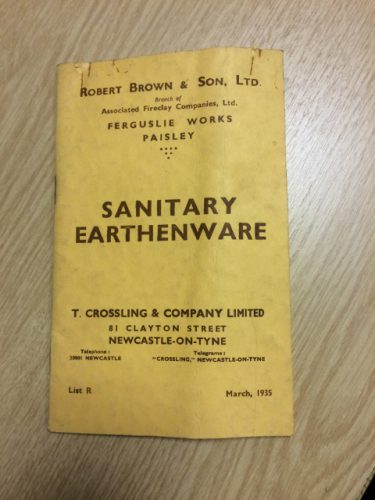 .
. 
1936 – Associated Clay Industries, makers of sanitary ware formed in 1926. By 1936 they own W.R.Pickup, John Crankshaw Co and Robert Brown & Son.
30/07/1936 – Glasgow Herald – An article on Associated Clay Industries Ltd and the progress of constituent businesses … In December 1934 we bought the business of Robert Brown & Son Ltd of Paisley and during the 18 months we have had this business under our control we have made the necessary alterations in the works and been able to improve production and restore the good name which used always to be attached to this firm for sanitaryware earthenware.
Below – 1944 – 1967 – Ferguslie Fireclay Works.

03/5/1947 – The Scotsman – The Ordinary shareholders of Associated Clay Industries, Ltd will shortly be invited to double their interest in the Company. The existing authorised share capital of £350,000 is to be increased to £1,000,000 and, subject to the approval of the Capital Issues Committee the board intends to issue a further £175,000 of Ordinary shares. The bulk of this new money will be absorbed by developments at the Company’s works at Ferguslie, Paisley. Associated Clay Industries, manufacturers of sanitary ware and fireplaces, &c have several works and mines in England also and own a number of subsidiary companies.
April 1959 – Clay Workers magazine (V 68 804) – New Owners for Scots Works – William Baird & Co. Ltd. of Glasgow, have acquired through their subsidiary J & R Howie Ltd., Hurlford Clayworks, Kilmarnock, the Ferguslie Works at Paisley of Association Clay Industries Ltd. J & R Howie will carry on the manufacture of vitreous China and earthenware sanitary products at the Ferguslie works as well as maintaining their own Kilmarnock plant. Associated Clay Industries Ltd took over the older Ferguslie works which were founded in 1836 as “Brown’s Brickworks” after the name of the founder Mr Robert Brown. Since they took over in 1934. Associated Clay Industries have done a considerable amount of improvement work at Ferguslie and modernised considerably in 1947. Modernisation of their four other plants was also needed but because of restricted trading and lack of prospects new capital was not raised and in September of last year, a receiver was appointed. (Information from Ann Los, East Yorks).
24/03/1971 – The Glasgow Herald – Paisley loses a landmark – Paisley lost a landmark yesterday when the oldest industrial chimney in the town was demolished. The demolition of the chimney at Browns Brickworks on the south side of the main road between Paisley and Elderslie was carried out by the steeplejack firm of Redmond Bros who used explosives to bring it down. The chimney built in 1837 was originally 286 feet high but over the years the height was reduced. Latterly it had become a danger. The site is now used by industrial and commercial concerns.
1979 – The 1985 publication ‘A survey of Scottish brickmarks’ suggests that Shanks and Co, Barrhead were using part of the site at this time. The site was also mostly demolished by this time.
*********************************
Information on George Jennings
George Jennings 1810 – 1882
Graces Guide – George Jennings
Below – This is a G Jennings Poole stamp. Found on a water/sewer pipe by Dr Jorg Ansorge in Stralsund (Mecklenburg-Vorpommern), Germany, a seaport town at the Baltic Sea coast.

Link to a similar pipe found in Poole.
***************************
Robert Brown Ferguslie stoneware ornamental lions.
***************************************
A pair of Scottish stoneware urns on pedestals stamped – Ferguslie, Brown & Son Paisley. 48 in. (122 cm.) high overall.
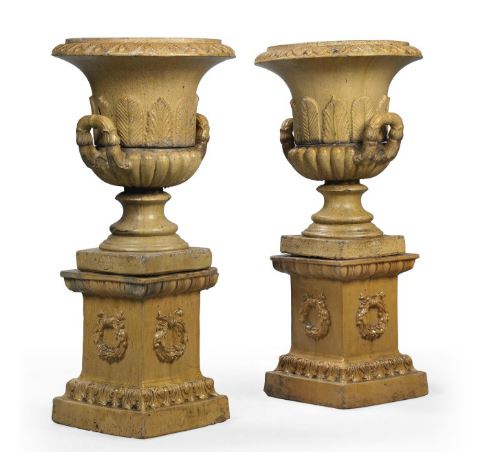
Below – How the Ferguslie Works, Paisley look today ( Google maps 2017).
**********************
Source Kenneth Sanderson – In 1858 the Robert Brown and Sons, Ferguslie Fireclay Works, Paisley were producing 12,000 tons a year of firebricks, chimney cans, boiler flue covers and ornamental garden vases. This was a large tonnage for those days and must have been built up over some years. Slaters directory 1867 mentions that they were producing fireclay goods of every description. Robert Brown senior died in 1900 (?) and was succeeded by his son Robert who incorporated the company in April 1902. The capital was substantial:25,000 6% £1 preference shares and 25,000 £1 ordinary shares. The profits for the previous 6 years had averaged £7,525 but had dropped ominously in the last 2 years which was said to be due to the large coal price increases. The mineral leases on the lands of Brediland and Meikleriggs were due to expire at Martinmas 1904, only a short time ahead. but other sources of fireclay were said to be available locally. Sanitary pottery was said to be the most profitable business and this was based on the raw materials from the south coast of England. Perhaps not surprisingly profits continued to fall and serious losses were incurred during the 1914 – 1918 war. The company struggled on until liquidated in 1934.
*******************************
Ferguslie Fire-Clay Works. These extensive works were established in 1839, and are carried on by Messrs. Robert Brown and Son. The productions are mainly chimney shafts in great variety and of good design, sewage pipes and sanitary goods of all kinds, garden vases and tazzae, flower boxes, suspenders, fern and flower stands, &c. of various designs ; statuary, both single figures and groups, architectural enrichments, pedestals, brackets, garden edgings, fire and other bricks and tiles, copings, finials, &c. Shortroods and Caledonia Works. These are brick and tile works connected with the Ferguslie Works of Messrs. Robert Brown and Co. Paisley Earthenware Works. Messrs. Robert Brown and Co.established these works in 1876, and at them produce white enamelled earthenware goods of a similar quality to those of Staffordshire. Their principal productions are cabinet stands and lavatories of every requisite shape both for domestic and shop fittings, plug basins, pans, and other sanitary appliances, baths of every kind (a speciality being the larger baths, five feet six inches in length, a size rarely attempted in earthenware), washing tubs, sinks, &c., plumber’s fittings, wash hand-table tops, with and without toilet ware, plain and coloured pavement and wall tiles, &c. Crown Works. At the Crown Crucible Works, belonging to Messrs. Robert Brown and Son, plumbago crucibles and kindred goods are manufactured. The marks are a crown and name, BROWN PAISLEY, and a crucible within an oval border surmounted by a crown.
********************************
Robert Brown was born at Rainger Home farm, East Kilbride, 15th July 1810. In 1815, his parents moved to Nether Capellie Farm, Neilston, and the boy’s first responsibility was to herd on the braes above Glen Killoch until he reached school age. He was educated at Neilston parish school, and showed an aptitude for Latin and Greek and Arithmetic—the intention being that he should proceed to the University.
This intention was departed from, and came to Paisley in 1827 and had built his home ‘Underwood Park’ on Underwood Road. Subsequently going to Glasgow, he acted for a time as reporter and sub-editor of the Chronicle newspaper, which helped to give a literary bias to his inclinations. In 1834, he was appointed Town Chamberlain to the Burgh of Paisley, and in 1845 was an accountant and share broker in Buchanan Street, Glasgow.
Having acquired the property of Ferguslie in 1850, he founded the Ferguslie Fire-clay Works. The firm originally produced fireclay linings for furnaces, garden ornaments and statuary for gardens and by 1876 the business had expanded to the manufacture of white sanitary earthenware, wall tiles and bricks. Browns Brickworks remained a significant manufacturer and employer until the mid-1970s.
In 1854, he entered the Town Council for the Fourth Ward, and two years after, in 1856 was elected Provost of Paisley, as which he served until 1859. Retired from his term in office he turned to literary work, the result being the publication of a series of works: History of the High Church, History of the Grammar School and Academy, History of Burns Clubs, Memoirs of Paisley Poets, and his greatest work, A History of Paisley, he is also believed to be the author of the ‘Paisley Pamphlets’, a collection of ephemera rich in social history covering the period 1739 – 1893
Robert Brown died in 1895 leaving an estate to the value of £23,962 (£2,571,589 today).
